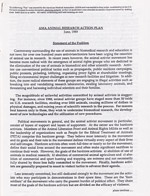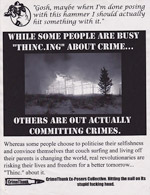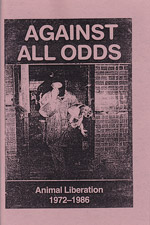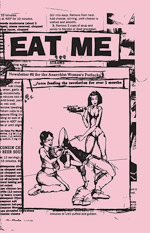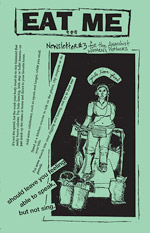Spectacular Times #10: Animals
Spectacular Times #10: Animals (1980? UK.)
In the late 1970s and early 1980s, Larry Law authored a series of booklets analyzing various issues from a situationist perspective. Consisting of statements by Law, cut and paste articles taken from newspapers at the time, and a little bit of humor, the Animals issue of Spectacular Times reminds of us the deep connections between animal liberation and situationist thought. (Ronnie Lee says that the founding of the ALF was influenced by his appreciation for the Angry Brigade, a British armed revolutionary group whose politics some, Lee included, mark as situationist.)
One article inside concerns the ambivalence and even animosity directed at the animal rights movement from the British left. “Despite all this activity the animal liberation groups are largely ignored by other political groups. Perhaps the politicos are ashamed. In the past five years the animal liberation activists have undertaken more direct action and caused more physical and financial damage to their enemies than the entire British revolutionary left put together. (Including those groups who claim to hold ‘direct action’ as a basic tenet of their philosophy.)” The booklet continues in much the same vain and makes for a great, albeit short read.
AMA Animal Research Action Plan
AMA Animal Research Action Plan (1989, leaked document, Chicago, IL. USA)
Long before the rise of whistle-blowing superstar WikiLeaks, the animal rights movement had been obtaining documents that our opposition never intended for us to see. One significant example of this was when the North American ALF Supporters Group obtained the American Medical Association’s plan to counter the animal rights movement in the United States. This plot, which became popularly known in the movement as the “AMA White Paper,” was quickly disseminated to the movement through old fashioned postal mail and excerpts in sympathetic periodicals.
The plan itself was pretty basic and involved elements still in use by corporate PR and security firms to this day. Essentially, a wedge was to be driven between the militant aspects of the movement and the national organizations, the public was to be told that animal rights activists are anti-science and stood in the way of “choices” which the average person may wish to make, and that congress should be heavily lobbied to increase penalties for people breaking the law to save animals. These tactics are still used against the movement today, and this publication remains a vital read for those fighting animal slavery.
Crimethunk poster
Crimethunk poster (2001, Seattle, WA. USA)
By the late 1990s, it had become clear that many people were using the imagery of Crimethinc to appear tough while simultaneously using the selfishness-as-virtue doctrine of the group to justify doing nothing. Fed up with that trend, and all the young shoplifting hipsters in Carharrts who slept on my couch falling off the vegan wagon, I began my own group: The Crimethunk Ex-Posers Collective. This poster is all that remains of the controversial imagery I made attacking Crimethinc’s self indulgence masquerading as politics. The most controversial of those images was a sticker now lost to history which read, “The opposite of Evasion is confrontation.”
UK ALF Supporters Group newsletter Barry Horne tribute issue
UK ALF SG Barry Horne tribute issue. (2002, London, England.)
Although this was not a stand alone issue of the SG newsletter, we wanted to post it separately in order to highlight Barry Horne’s contributions to the liberation of animals.
Prior to his death on hunger strike, Barry had participated in many famous actions in the UK. From attempting to liberate dolphins, to raids on Park Farm, Interfauna, and Boots, and ultimately a campaign of arson attacks that resulted in his arrest, he never failed to risk his own freedom as he fought to bring it to others. This edition tells many of the stories of his time in the trenches, and the self sacrifice that led to his demise. It is essential reading for militant activists of all stripes and generations.
Memphis Vegan #5
Militant Couple seeking Memphis Vegan
US: We are two friends who run a website archiving animal rights and environmental publications. Him: A rabid hoarder of rarities. Her: Amused by the meshing of conservative politics and veganism. You: A little odd but a fun third to our party. Come to us and find out all the magic we have to offer. Feel free to bring along your boy X Shawn Youngblood X. Smooooch.
(In other words, we’d really like to track down more issues of this publication. Please contact us at conflictgypsy ((at)) gmail ((dot)) com if you can help us obtain this treasure!)
Against All Odds
Originally published in England as a book 25 years ago, Against All Odds was regularly distributed in North America as a low cost zine. It remains one of the best publications documenting the rise of the Animal Liberation Front and the Animal Liberation Leagues in England.
In many ways, the 1980s was the high water mark of the Animal Liberation movement. In 1984, thousands of people in England participated in direct action against vivisection, staging large scale raids against six labs. Multitudes of people would overwhelm security in broad daylight and remove the oppressed creatures inside, often causing minor damage along the way and taking out valuable footage which was used to grow the movement. Many dozens of arrests followed these raids, but it is arguable that police response was not the cause of death of this mass militant movement taking shape in the UK.
Around this same time we saw the emergence of groups such as the Hunt Retribution Squad and Animal Rights Militia. Rather than rejecting the idea that animal rights activists were fanatics, HRS and ARM embraced that term and reveled in the negative imagery presented by the media. The Hunt Retribution Squad went so far as to release images of masked activists wielding clubs, chainsaws, and even pavement cutters. The front pages of newspapers widely reported on threats made by HRS to harm hunters if they attacked human opponents of hunting. In the end these counter-assaults never took place, but the damage was done. This type of macho posturing was repellent to many in the movement, and it provided great fodder for the police, courts, and conservative PR teams to use in the war against direct action. Certainly, the few acts of violence taken by the Animal Rights Militia could not outweigh the value of the mass raids and rising public consciousness taking place at the time, and contributed to the recession of a growing struggle for non-human emancipation.
Written in accessible language and unafraid of nuance, its tactical analysis and historical documentation remain valuable to this day. Against All Odds is essential reading for the modern animal liberationist.
Contention Builder
Contention Builder (Publication dates unknown, likely 1997. San Diego, CA)
Although the mid to late 1990s brought a resurgence of participation to the animal rights movement, the new generation of liberationists also had an unfortunate tendency towards posturing, machismo, and puritanical language that bordered on the cultish. These newcomers plagued AR culture with cartoonish militant names such as JIHAD (Justice through Insurrection by Humans for Animal Defense), CLAW (Committed Liberation Activists of the West), ARMY (Animal Rights Militant Youth), Vegan Frontline, and the Vegan Militia Movement. It was the latter that brought us two issues of the eclectic, and at times frustrating, Contention Builder.
Many of the members of the Vegan Militia Movement went on to do excellent activism. Their early attempts at publishing, however, were somewhat rough. Packaged between artistic, eye grabbing covers, the interior pages of Contention Builder were filled with reprints, PETA fact sheets, vegan recipes, and the occasionally an original article attacking the credibility of bands like Earth Crisis. Worst of all were the heavy handed admonitions at the back of each issue for people to embrace the “Hardline movement,” a bizarre spin off of Straight Edge that rejected drugs, homosexuality, sex without procreation, abortion, and which later incorporated aspects of Taosim and Islam. Hardliners threatened to use violence against people who abused animals, but these statements were never acted upon and now appear to be the juvenile venting of angry young men.
Issue #1 of Contention Builder came packaged with a tract advertising the mission statement of the Vegan Militia Movement. Chuckle along with these earnest but silly run-on sentences: “WE BELIEVE IN ONE ETHIC- THAT ALL LIFE HAS THE VIRTUE TO LIVE OUT LIFE FROM BIRTH TO NATURAL DEATH – FREE FROM ALL UNETHICAL VALUES. WE MUST STRIFE [sic] AGAINST THOSE WHO ARE DESTROYING THIS WORLD WITH IMPURE AND WARPED VALUES BY VOICING OURSELVES AND TAKING ACTION AGAINST THEM.” Ah, yes, the good old days when hardcore lyrics replaced political discussion and the caps lock was permanently depressed.
But CB is worthy of notice not so much because of its content, but its regional importance to the movement in Southern California. For all the oddball rhetoric and over-reliance on reprints, the magazine still inspired young people to get active and attend protests throughout San Diego and Orange County. Space was given to examining issues ignored elsewhere in the animal rights movement, and violence against women, repression of the Black Panther Party for Self Defense, and US Imperialism all received coverage. In the end, the sincerity of many members of this group was proven outside of the pages of the zine. All these years later many of them are still active and contributing to animal rights. Perhaps that is the best legacy of their old publication.
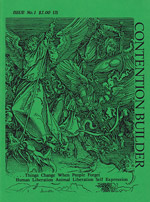 |
 |
Eat Me
EAT ME (1997-1998 New York, NY USA.)
Before the term snacktivist became derogatory, several amazing publications such as Soy Not Oi and Raggedy Anarchy promoted veganism and protest alongside recipes for tasty food. One much more obscure publication, EAT ME, was written by best selling vegan cookbook author Isa Moskowitz. Although the content doesn’t match the focus of most of our site, there is certainly a fun archival nerd collector value to seeing one of the most prominent faces of veganism during her radical youth. And yes, each issue contains a recipe. We are happy to have a new introduction to these newsletters from Isa herself.
“I made these as newsletters for the Anarchist Women’s Potlucks in 1997/1998. It was weird timing, because people had email and stuff but it was still a real privilege to have internet at home, so everything was done word of mouth. If you read a few issues, you can see that we used voicemail to let people know when they next one will be. So we were kind of cutting edge technology for the 90s, if only we had a beeper! I wrote them on a word processor, then cut and paste and just filled in some of the art with pictures of lips or whatever. I would love to try some of the recipes now, I was a pretty shitty recipe writer back then. So many awesome things came out of those potlucks, including Bluestockings Books which is still standing today. It was really the end of an era! Pre-internet activism, where you kinda had to know everyone face to face. There is definitely something valuable in that. I love seeing these because they seem so innocent, even though I felt jaded back then.”



